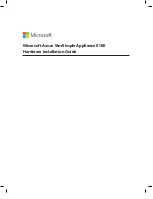
1033
Configuring EtherChannels
Information About Configuring EtherChannels
LACP Interaction with Other Features
The DTP and the CDP send and receive packets over the physical ports in the EtherChannel. Trunk ports send and receive
LACP PDUs on the lowest numbered VLAN.
In Layer 2 EtherChannels, the first port in the channel that comes up provides its MAC address to the EtherChannel. If
this port is removed from the bundle, one of the remaining ports in the bundle provides its MAC address to the
EtherChannel.
LACP sends and receives LACP PDUs only from ports that are up and have LACP enabled for the active or passive mode.
EtherChannel On Mode
EtherChannel
on
mode can be used to manually configure an EtherChannel. The
on
mode forces a port to join an
EtherChannel without negotiations. The
on
mode can be useful if the remote device does not support PAgP or LACP. In
the
on
mode, a usable EtherChannel exists only when the switches at both ends of the link are configured in the
on
mode.
Ports that are configured in the
on
mode in the same channel group must have compatible port characteristics, such as
speed and duplex. Ports that are not compatible are suspended, even though they are configured in the
on
mode.
Caution:
You should use care when using the on mode. This is a manual configuration, and ports on both ends of the
EtherChannel must have the same configuration. If the group is misconfigured, packet loss or spanning-tree loops
can occur.
Load Balancing and Forwarding Methods
EtherChannel balances the traffic load across the links in a channel by reducing part of the binary pattern formed from
the addresses in the frame to a numerical value that selects one of the links in the channel. EtherChannel load balancing
can use MAC addresses or IP addresses, source or destination addresses, or both source and destination addresses.
The selected mode applies to all EtherChannels configured on the switch. You configure the load balancing and
forwarding method by using the
port-channel load-balance
global configuration command.
With source-MAC address forwarding, when packets are forwarded to an EtherChannel, they are distributed across the
ports in the channel based on the source-MAC address of the incoming packet. Therefore, to provide load balancing,
packets from different hosts use different ports in the channel, but packets from the same host use the same port in the
channel.
With destination-MAC address forwarding, when packets are forwarded to an EtherChannel, they are distributed across
the ports in the channel based on the destination host’s MAC address of the incoming packet. Therefore, packets to the
same destination are forwarded over the same port, and packets to a different destination are sent on a different port in
the channel.
With source-and-destination MAC address forwarding, when packets are forwarded to an EtherChannel, they are
distributed across the ports in the channel based on both the source and destination MAC addresses. This forwarding
method, a combination source-MAC and destination-MAC address forwarding methods of load distribution, can be used
if it is not clear whether source-MAC or destination-MAC address forwarding is better suited on a particular switch. With
source-and-destination MAC-address forwarding, packets sent from host A to host B, host A to host C, and host C to
host B could all use different ports in the channel.
With source-IP address-based forwarding, when packets are forwarded to an EtherChannel, they are distributed across
the ports in the EtherChannel based on the source-IP address of the incoming packet. Therefore, to provide
load-balancing, packets from different IP addresses use different ports in the channel, but packets from the same IP
address use the same port in the channel.
Summary of Contents for IE 4000
Page 12: ...8 Configuration Overview Default Settings After Initial Switch Configuration ...
Page 52: ...48 Configuring Interfaces Monitoring and Maintaining the Interfaces ...
Page 108: ...104 Configuring Switch Clusters Additional References ...
Page 128: ...124 Performing Switch Administration Additional References ...
Page 130: ...126 Configuring PTP ...
Page 140: ...136 Configuring CIP Additional References ...
Page 146: ...142 Configuring SDM Templates Configuration Examples for Configuring SDM Templates ...
Page 192: ...188 Configuring Switch Based Authentication Additional References ...
Page 244: ...240 Configuring IEEE 802 1x Port Based Authentication Additional References ...
Page 298: ...294 Configuring VLANs Additional References ...
Page 336: ...332 Configuring STP Additional References ...
Page 408: ...404 Configuring DHCP Additional References ...
Page 450: ...446 Configuring IGMP Snooping and MVR Additional References ...
Page 490: ...486 Configuring SPAN and RSPAN Additional References ...
Page 502: ...498 Configuring Layer 2 NAT ...
Page 770: ...766 Configuring IPv6 MLD Snooping Related Documents ...
Page 930: ...926 Configuring IP Unicast Routing Related Documents ...
Page 976: ...972 Configuring Cisco IOS IP SLAs Operations Additional References ...
Page 978: ...974 Dying Gasp ...
Page 990: ...986 Configuring Enhanced Object Tracking Monitoring Enhanced Object Tracking ...
Page 994: ...990 Configuring MODBUS TCP Displaying MODBUS TCP Information ...
Page 996: ...992 Ethernet CFM ...
Page 1066: ...1062 Using an SD Card SD Card Alarms ...
















































